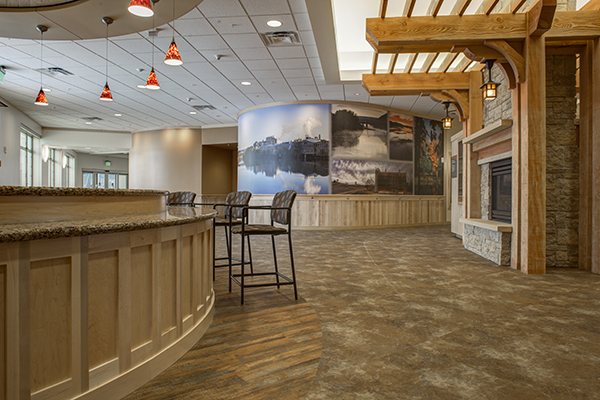What Do Interior Designers Do? They Make All the Difference

What do Interior Designers do?
- Combine knowledge of design principles and code requirements to create an aesthetically pleasing, efficient space that meets the budget
- Impact behavior, from influencing buying habits to increasing employee retention
- Coordinate with a range of consultants, bringing designs to life within schedule
- Consider a client’s unique needs and requirements
Like Ayres Associates’ engineers and architects, Anne Peterson is a creative, analytical, problem-solving professional. But rather than designing bridges and roads, Anne’s expertise lies in helping commercial and healthcare clients design interior spaces that enhance their buildings’ functionality, safety, efficiency, and look.
“Many people have the misconception that all an interior designer does is pick out paint colors, furniture, and decorations, but there’s so much more to it than that,” Anne says. “We want to know how people are going to use the space and what behaviors clients want to both encourage and discourage.” She explains that interior designers combine their knowledge of design principles and code requirements to create good-looking, efficient, and safe environments that meet clients’ budgets.
Interior design makes a difference in our world. According to the American Society of Interior Designers’ (ASID) website, “Studies have shown that design can influence consumer purchasing, customer satisfaction, and client confidence. It has been linked to increased worker productivity and employee retention, to infection control and patient recovery in healthcare settings, to improved concentration and learning in schools, and to reduced injuries in restaurants and bars.”
To make that happen, whether she’s designing memory care facilities, a school, a clinic, or an office, Anne makes a point of meeting with many different users, from the facilities staff to the CEO. For example, the facilities director may want to consider a surface’s life cycle costs by analyzing the hours required for ongoing maintenance, while the CEO may be more concerned about the initial cost and how it looks. “We do a lot of prioritizing and consensus-building to help our clients figure out the best way to spend the money to achieve their goals,” she says.
Interior designers coordinate with a variety of consultants to make sure a plan can be built the way it’s drawn. For example, the spaces need to consider the interior comfort of the occupants, including acoustics, lighting, and climate, as well as occupant health and safety, including factors like air quality. Interior designers keep up with the current trends in technology and materials to incorporate ever-changing products into their designs.
As an example, Anne described the tasks she might complete for a senior living project, which could include independent living, assisted living, memory care, or a skilled nursing facility. First she collaborates with the architects and the client to determine the project’s goals. From there she’ll work with the architects to determine the size and layout of the rooms. Then she’ll get involved in programming the space, including selecting the furniture and fixtures, choosing finishes that will meet the unique requirements of long-term care residential facilities, and procuring artwork that reflects that unique community to create an atmosphere that feels like home. She often contacts historical societies, chambers of commerce, or other organizations to find old photographs from the area to create artwork and wall murals that residents will find comforting and meaningful. She even shops for and makes decorations that give the facility the final touches that make it feel like home.
The accompanying photo of the Wisconsin Veterans Home in Chippewa Falls, Wisconsin, shows the end result of our interior design team’s work. The team considered this client’s unique requirements, which included evaluating a product’s durability, maintenance requirements, and warranty, along with being aesthetically pleasing and using products made in the United States. The photos on the wall reflect scenery from the Chippewa Valley and surrounding region.
So, yes, interior designers do “pick out colors,” but their services go way beyond that to deliver safety, efficiency, and comfort.

Post a comment: